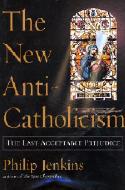Issue Date: August 1, 2003
Reviewed by JIM FISHER If the clerical sex abuse scandal had never happened, the biggest news in the field of American Catholic studies would be the emergence of a scholarly literature that looks hard at the church’s often troubled relationship with American culture. From John McGreevy’s recently published Catholicism and American Freedom: A History to my Fordham colleague Mark Massa’s forthcoming Anti-Catholicism in America: The Last Acceptable Prejudice, Catholic scholars are challenging time-honored “Americanist” assumptions while reaffirming the creative potential of the church’s engagement with the national culture. Philip Jenkins’ The New Anti-Catholicism: The Last Acceptable Prejudice, shares a subtitle with Massa’s book as well as certain features of the new literature on Catholicism and American culture. Jenkins is a prolific author who has written a book on an earlier clerical sex abuse scandal (Pedophiles and Priests). Publishers have been scrambling to release books pertinent to the current crisis and The New Anti-Catholicism bears the marks of this haste: Moral theologian Charles Curran, for example, is identified as having been a professor at American University rather than The Catholic University of America; John F. Kennedy’s presidential campaign is described as the “1964 race.” Jenkins is also prone to some rather peculiar general observations. Under the influence, perhaps, of the recent field of “whiteness studies” and its stress on the cultural construction of racial categories, Jenkins asserts: “Literally, through the end of the 19th century, American Catholicism was a predominantly non-white religion.” Quirks aside, Jenkins plausibly argues that a traditional American hostility to Catholicism on religious grounds gave way in recent decades to a liberal-secularist animosity directed toward the church’s moral teachings. The depth of this disdain led champions of pluralism to cast Catholicism beyond the pale of the tolerance extended to all other “minority” groups. “The argument of this book,” writes Jenkins, “is not so much that Catholicism is subjected to unjust abuse, but that it is virtually the only major institution with which such liberties are still permitted.” Jenkins’s case is bolstered by a litany of rhetorical attacks on the church from liberals, feminists and gay rights activists. Though he claims anti-Catholic bigotry is ignored by the mainstream secular media (when it is not promoting its own version), the cases he cites should be quite familiar to anyone with even a casual recollection of the “culture wars” of the late 1980 and ’90s. Readers of conservative Catholic publications will also recognize a central refrain in his argument: “The upsurge of liberal dissidence within the church meant that the mainstream media had more Catholic controversies to report, and also made it far easier to express views hostile to Catholicism.” This “Catholic Civil War” has emboldened the media -- which according to Jenkins tends to form a “solid front” -- to promote Catholic bashing without fear of the reprisals a unified church might generate in response. Yet a militant response from church officials did not prevent Paul Blanshard’s anti-Catholic tracts of the late 1940s and early 1950s from becoming bestsellers and may indeed have helped promote the books. Jenkins views anti-Catholicism as a one-way street and pays no regard to the broader marketplace of ideas within which religious disputation increasingly operates. Jenkins reminds us, for example, that the Irish singer Sinead O’Connor tore apart a photograph of Pope Paul John II on a 1992 telecast of “Saturday Night Live.” He fails to mention, however, that in a subsequent concert appearance O’Connor faced a jeering, largely non-Catholic audience that hooted her off the stage. The incident effectively ended her career as a pop star. Jenkins claims that recent books by such celebrity Catholic authors as James Carroll (Constantine’s Sword) and Garry Wills (Papal Sin) deploy “an often-ferocious range of anti-church arguments, which are readily adapted and amplified by the most fervent anti-Catholics.” Yet he ignores critiques of these books found in liberal Catholic publications as well as in numerous secular outlets, where the emotion-driven arguments of Carroll and Wills have been widely scrutinized for historical inaccuracies and distortions of emphasis. Catholics are involved in the American marketplace of ideas and information at every level, something that could not have been said even a few decades ago. While Jenkins predictably interprets the sex abuse scandals in the context of a “seemingly indestructible” anti-Catholic tradition, he would have done better to consider the role of genuinely faithful Catholics in covering the story. From newsrooms in Boston, Newark, Philadelphia, St. Louis and yes, even at the dreaded New York Times, truly faithful Catholic reporters and columnists performed important work under trying circumstances. When historians treat the scandals in subsequent decades, the work of these professionals will provide an invaluable documentary record. Strains of anti-Catholicism may well persist in the rhetorical arsenal of the church’s critics, but that cannot change a basic social fact: The Catholics are everywhere. Jim Fisher is co-director of the Center for American Catholic Studies at Fordham University in the Bronx, N.Y. National Catholic Reporter, August 1, 2003 |
